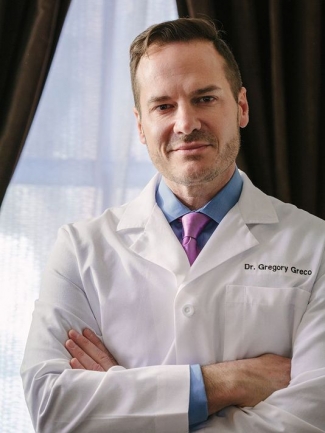
Q&A with Dr. Gregory Greco
According to the American Society of Plastic Surgery, 17.5 million cosmetic surgery procedures were performed in the United States in 2017.1 A common concern for people undergoing these procedures, or any surgery really, is the fear of being out of commission from their daily routine for an extended period. That’s why patients often request opioids. But plastic surgeons are seeing positive results with a long acting, non-opioid option that effectively manages pain after surgery and reduces – or in some cases eliminates – the need for opioids. As a result, patients don’t have to deal with the unwanted side effects of opioids, the long-term risks of dependence, or leftover medications in the home available for potential misuse.
Dr. Gregory Greco, a board-certified plastic surgeon and Chairman of the Division of Plastic Surgery and the General Surgery Residency Program Director at Monmouth Medical Center, recognizes the value of managing pain with the fewest opioids possible, and utilizes opioid alternatives for his patients following a variety of procedures. Dr. Greco notes that this strategy allows many of his patients to recover from surgery with little to no need for opioids and believes it is critical for surgeons to offer non-opioid options whenever appropriate.
Dr. Greco, who also has a private practice with offices in both Red Bank, New Jersey and Manhattan, New York, spoke with Shatterproof about the importance of using non-opioid options in his field of medicine and how he encourages all patients to have an open discussion with their doctor about pain management options prior to any surgery.
As the opioid epidemic continues to plague the nation, do you feel that patients are deciding to put off or forgo sought-after plastic surgery procedures out of fear of becoming dependent on opioids?
The side effects of opioids, including the risk of dependence, can certainly be a deterrent for some patients. This is an understandable concern, as we have seen that opioid use disorder does not discriminate based on race, religion, age, gender or region. Fear of that possibility may prevent someone from choosing to have a desired elective procedure.
Fortunately, opioids are no longer the only option for patients. There are several effective non-opioid options that can be used to treat pain following surgery. I prioritize having a conversation about pain management options during every presurgical consultation I have with a patient. These discussions help my patients make an informed decision about which treatments are best for their individual needs.
What are some things that patients should discuss when having a conversation with their surgeon about pain management options?
I encourage patients to ask their doctor about all treatment options and pain management combinations. When having this discussion with your doctor, be proactive about discussing personal factors that may influence your treatment needs such as pain tolerance and the level of caregiver support that will be available to you during your recovery.
Additionally, do not be afraid to express your concerns about pain medications or the associated side effects, and ask your surgeon if there are alternative options that may reduce your need for opioids.
As a plastic surgeon who specializes in reconstructive surgeries, many of the patients who come into your office are women. Knowing that research has found women to be especially at risk for persistent opioid use after surgery, what advice do you have for these patients?
It is true that women are a vulnerable population when it comes to opioids, as a recent national analysis found 40 percent more women than men become persistent opioid users following surgery, meaning they are still taking opioids three to six months after their procedure. Additionally, women make up 92 percent of plastic surgery patients.2 Although every patient should understand the risks of opioids before using them, it’s especially important that women have a discussion with their surgeon about the pain management options available to them prior to surgery.
As a patient, it’s your right to understand everything about a medication prescribed to you. Patients should feel comfortable and empowered to ask their doctor to explain why the suggested treatment option is best, how it works, and what side effects to expect. I encourage all patients to advocate for a non-opioid option if it’s available to them, and to proactively ask for alternatives, even if their doctor does not initiate the discussion.
The expectation of pain during the recovery period following more extensive procedures can often be concerning to mothers who have a child to care for at home. For patients having multiple surgeries performed at once, are opioids the only effective way patients can manage their pain after surgery?
Even when undergoing extensive procedures, or getting multiple procedures done at once, It’s important for patients to know that opioids are not the only effective way to manage postsurgical pain. In fact, I’ve had many patients require minimal to zero opioids after complex procedures because of the non-opioid option I offer in my practice, which I inject into the surgical sites to numb the areas for several days.
In what ways has the opioid crisis affected your prescribing habits?
The opioid crisis has certainly affected my prescribing habits and the way I manage my patients’ pain. Before each procedure, I have a very detailed discussion about pain management with each patient. I do not prescribe more than a week’s worth of opioids, and it is very rare for me to write a second prescription. Instead, I often use a local analgesic injected into the surgical site to provide patients with long-lasting pain relief after surgery. Although time and patience are necessary for a full recovery, my patients report having a comfortable experience after surgery, and tend to be back on their feet in as little as a week. Through the use of non-opioid multimodal pain management, patients never experience the immediate discomfort postoperatively, which helps set their recovery tone in a positive manner.
In the past, a patient undergoing a double mastectomy and breast reconstruction would likely receive a few weeks’ supply of opioids following the procedure. Now, with the use of multimodal therapy, I have some patients who receive just one or two pills, and rarely need to prescribe more than several days of opioids for postsurgical use. I’ve been able to effectively minimize my patients’ discomfort following surgery without the use of opioids.
What kind of reconstructive procedure do you use this long acting non-opioid option for?
In my practice, I strive to use this non-opioid option for all surgical procedures. For example, I use it for breast reconstruction, a surgery that allows a woman’s breasts to be rebuilt following a mastectomy or lumpectomy. I also use it during tummy tucks, liposuction on the waistline, breast augmentation and more. With recent research revealing that in 2016 alone, nearly 3 million patients undergoing surgery became newly persistent opioid users, I work to minimize opioid use whenever possible.3
Do you think the opioid crisis will have a lasting effect on how surgeons help patients manage pain?
As the opioid crisis continues to plague the country, changes have been implemented at a national, state and local level. New legislation in some states has placed restrictions on the number of pills a doctor can prescribe, which has led doctors to research effective non-opioid options to manage pain after surgery. Because of these restrictions, doctors are becoming more and more conscious of thinking through pain management options for each individual patient, and not simply writing an opioid prescription.
Is plastic surgery the only medical specialty that offers non-opioid options to treat pain after surgery?
Non-opioid options can be used to manage pain after a variety of surgeries including C-sections, total knee or hip replacement, wisdom tooth extraction, hysterectomies, gallbladder removal and weight loss surgery, among many others. No matter how simple or complicated the surgery, I encourage you to speak with your doctor to determine what pain management option is best for your individual needs. Knowing that opioids are not the only option for many procedures, patients can educate themselves on their choices in pain management with resources such as shatterproof.org/choice-matter prior to surgery.
Originally published in 2018.




